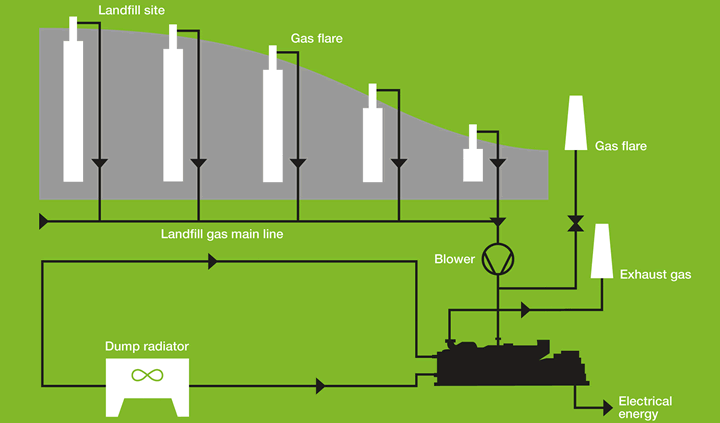Introduction – Landfill gas is a complex mix of different gases created by the action of microorganisms within a landfill. Landfill gas is approximately forty to sixty percent methane, with the remainder being mostly carbon dioxide. Trace amounts of other volatile organic compounds comprise the remainder (<1%). These trace gases include a large array of species, mainly simple hydrocarbons. Landfill is created during the anaerobic decomposition of organic substances in municipal solid waste (MSW) and commercial and industrial wastes. Depending upon the landfill design and its management, as well as waste composition, compaction, moisture and several other factors, thousands of landfills are available worldwide to collect and utilize this valuable renewable energy source for power generation. If landfill gas is allowed to escape to atmosphere, methane contained within it is a powerful greenhouse gas, 21 times more so than carbon dioxide. Therefore, its prevention of escape to atmosphere and its utilization as a renewable fuel source is a win-win situation.
Production of Landfill gases
Landfill gases are the result of three processes:
- Evaporation of volatile organic compounds (e.g., solvents)
- Chemical reactions between waste components
- Microbial action, especially methanogenesis.
The first two depend strongly on the nature of the waste. The dominant process in most landfills is the third process whereby anaerobic bacteria decompose organic waste to produce biogas, which consists of methane and carbon dioxide together with traces of other compounds. Despite the heterogeneity of waste, the evolution of gases follows well defined kinetic pattern. Formation of methane and CO2 commences about six months after depositing the landfill material. The evolution of gas reaches a maximum at about 20 years, then declines over the course of decades.
Landfill Gas Collection
For a landfill restoration that prevents greenhouse gas from migrating into the atmosphere while avoiding offensive smells and smouldering fires, the gas must be continuously extracted under controlled conditions. Perforated tubes are drilled into the landfill body and interconnected by a pipework system. Using a blower, the gas is sucked from the landfill. A well-designed gas collection system will flexibly capture the landfill gas from various spots and handful high temperatures, leachate, condensates and air content – thus ensuring a cost-efficient collection as well as stable landfill gas quality. Several engineering companies specialize in this field and offer their services on a worldwide basis.
Application
Jinan gas engines are specifically designed to run at full load with high efficiency and high availability, despite a low heating value and fluctuating gas quality and pressure. The high quality and specially designed engine parts resist the impurities that usually appear in this type of fuel. Before the landfill gas can be fed into the gas engines, it needs to be dried and compressed. Severe contaminants such as siloxanes should be removed if exceeding a certain level. Not only will these measures considerably increase the availability of the generator, but they will also reduce the costs associated with operation.
Since landfills are usually located near big cities, emission standards are becoming more and more ridged in many countries. To comply with these standards, the whole system must be managed, beginning with the fuel gas conditions up to the installation of an exhaust treatment service, if needed. Green Power Utility is committed to not only supplying the gas engines, but also offering ancillary equipment and giving support for an integrated solution, from the gas flange to the grid connection.
Benefits
- Smooth operation despite low heating value and fluctuations in gas composition and pressure.
- Electrical efficiency of up to 40%, and up to 85% efficiency in the case of combined heat and power.
- Alternative disposal of a problem gas while simultaneously harnessing it as an energy source.
- Revenues for power and heat production when fed into the public grid.
- Carbon credits for reduction of methane releases or special renewable energy tariffs.
- Reduce Greenhouse Gas Emissions
- Reduce Environmental compliance costs
- Reduce Air pollution by offsetting the use of Non-renewable resources

